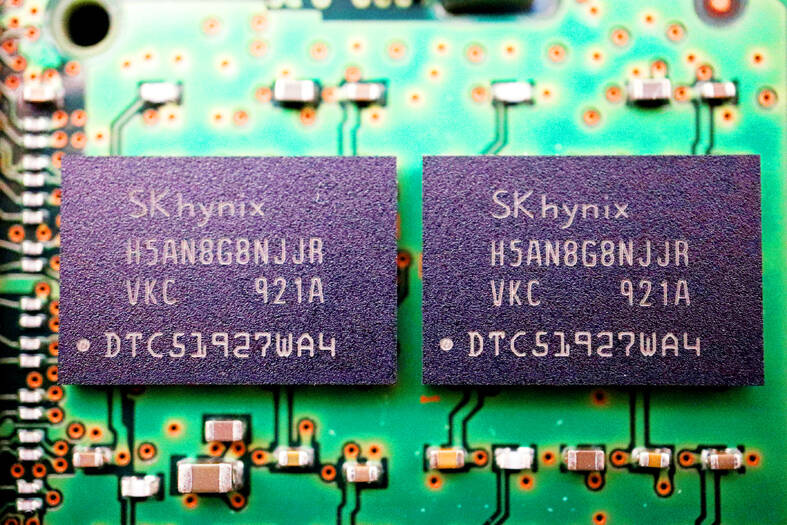South Korea’s semiconductor production last month fell by the highest rate since the global financial crisis, weighing on the nation’s industrial output and pointing to a further cooling of overseas demand for tech components as the world economy slows.
Chip production shrank for a fourth straight month, falling 15 percent from a year earlier in the largest drop since 2009, data released yesterday by Statistics Korea showed.
Overall industrial production contracted 3.7 percent from a year earlier for the biggest fall since the start of the COVID-19 pandemic, the data showed.

Photo: Reuters
The drop in activity speaks to weakening recovery momentum in a nation closely tied to the world economy. South Korea’s growth is already under pressure from falling exports and rising interest rates at home, with the gloomy outlook overseas adding to concerns.
The probability of recessions in major overseas economies such as the US is rising as the US Federal Reserve leads a wave of monetary tightening to combat inflation, and as Russia’s invasion of Ukraine continues.
Although China’s about-turn on its “zero COVID-19” policy suggests its economy might regain strength, a surge in infections would complicate the picture.
The weakening chip demand adds to an array of factors making South Korea’s economic outlook more uncertain, including the implications of a truckers’ strike that recently ended and a crowd-crush tragedy in Seoul, the South Korean Ministry of Economy and Finance said in a separate statement.
The cloudy outlook gives the Bank of Korea more reasons to be cautious as it mulls the end of its tightening cycle. The central bank has been hiking rates for more than a year, and is debating whether to carry out one or two more next year.
The latest output figures showed chip production was down 11 percent on a month-on-month basis, while semiconductor inventories climbed 20 percent from a year earlier last month, picking up from 12.9 percent the previous month, Statistics Korea said.
The double-digit increases in inventories since October underscores a global oversupply of memory chips, a sector in which South Korea leads production. Chipmakers are recalibrating their investment plans as they brace for a drop in demand for their products at home and abroad.

GROWING OWINGS: While Luxembourg and China swapped the top three spots, the US continued to be the largest exposure for Taiwan for the 41st consecutive quarter The US remained the largest debtor nation to Taiwan’s banking sector for the 41st consecutive quarter at the end of September, after local banks’ exposure to the US market rose more than 2 percent from three months earlier, the central bank said. Exposure to the US increased to US$198.896 billion, up US$4.026 billion, or 2.07 percent, from US$194.87 billion in the previous quarter, data released by the central bank showed on Friday. Of the increase, about US$1.4 billion came from banks’ investments in securitized products and interbank loans in the US, while another US$2.6 billion stemmed from trust assets, including mutual funds,

Micron Memory Taiwan Co (台灣美光), a subsidiary of US memorychip maker Micron Technology Inc, has been granted a NT$4.7 billion (US$149.5 million) subsidy under the Ministry of Economic Affairs A+ Corporate Innovation and R&D Enhancement program, the ministry said yesterday. The US memorychip maker’s program aims to back the development of high-performance and high-bandwidth memory chips with a total budget of NT$11.75 billion, the ministry said. Aside from the government funding, Micron is to inject the remaining investment of NT$7.06 billion as the company applied to participate the government’s Global Innovation Partnership Program to deepen technology cooperation, a ministry official told the

Taiwan Semiconductor Manufacturing Co (TSMC, 台積電), the world’s leading advanced chipmaker, officially began volume production of its 2-nanometer chips in the fourth quarter of this year, according to a recent update on the company’s Web site. The low-key announcement confirms that TSMC, the go-to chipmaker for artificial intelligence (AI) hardware providers Nvidia Corp and iPhone maker Apple Inc, met its original roadmap for the next-generation technology. Production is currently centered at Fab 22 in Kaohsiung, utilizing the company’s first-generation nanosheet transistor technology. The new architecture achieves “full-node strides in performance and power consumption,” TSMC said. The company described the 2nm process as

JOINT EFFORTS: MediaTek would partner with Denso to develop custom chips to support the car-part specialist company’s driver-assist systems in an expanding market MediaTek Inc (聯發科), the world’s largest mobile phone chip designer, yesterday said it is working closely with Japan’s Denso Corp to build a custom automotive system-on-chip (SoC) solution tailored for advanced driver-assistance systems and cockpit systems, adding another customer to its new application-specific IC (ASIC) business. This effort merges Denso’s automotive-grade safety expertise and deep vehicle integration with MediaTek’s technologies cultivated through the development of Media- Tek’s Dimensity AX, leveraging efficient, high-performance SoCs and artificial intelligence (AI) capabilities to offer a scalable, production-ready platform for next-generation driver assistance, the company said in a statement yesterday. “Through this collaboration, we are bringing two